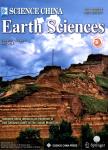Magnetic mineral diagenesis in the post-glacial muddy sediments from the southeastern South Yellow Sea:Response to marine environmental changes
Magnetic mineral diagenesis in the post-glacial muddy sediments from the southeastern South Yellow Sea:Response to marine environmental changes作者机构:Korean Institute of Geology
出 版 物:《Science China Earth Sciences》 (中国科学(地球科学英文版))
年 卷 期:2005年第48卷第1期
页 面:134-144页
核心收录:
学科分类:0709[理学-地质学] 081803[工学-地质工程] 070901[理学-矿物学、岩石学、矿床学] 07[理学] 08[工学] 0818[工学-地质资源与地质工程]
基 金:supported by the National Natural Science Foundation of China(Grant Nos.49976012 and 49736210)
主 题:environmental magnetism, magnetic minerals, diagenesis, ferrimagnetic iron sulphide, South Yellow Sea.
摘 要:Core YSDP103 was retrieved in the muddy deposit under the cold eddy of the southeastern South Yellow Sea, and the uppermost 29.79 m core represents the muddy sediments formed in the shelf since about 13 ka BP. The lower part from 29.79 to 13.35 m, called Unit A2, was deposited during the period from the post-glacial transgression to the middle Holocene (at about 6 14C ka BP) when the rising sea level reached its maximum, while the upper part above 13.35 m (called Unit A1) was deposited in a cold eddy associated with the formation of the Yellow Sea Warm Current just after the peak of post-glacial sea level rise. Rock-magnetic properties of the uppermost 29.79 m core were investigated in detail. The experimental results indicate that the magnetic mineralogy of the core is dominated by magnetite, maghemite and hematite and that, except for the uppermost 2.35 m, the magnetic minerals were subject to reductive diagenesis leading to significant decline of magnetic mineral content and the proportion of low-coercivity component. More importantly, ferrimagnetic iron sulphide (greigite) is found in Unit A2 but absent in Unit A1, suggesting the control of marine environmental conditions on the magnetic mineral diagenesis. Magnetic parameters show abrupt changes across the boundary between Units A1and A2, which reflects a co-effect of environmental conditions and primary magnetic components of the sediments on the diagenesis. Alternating zones of high and low magnetic parameters are observed in Unit A2, which is presumably due to periodic changes of the concentration and/or grain size of magnetic minerals carried into the study area.



